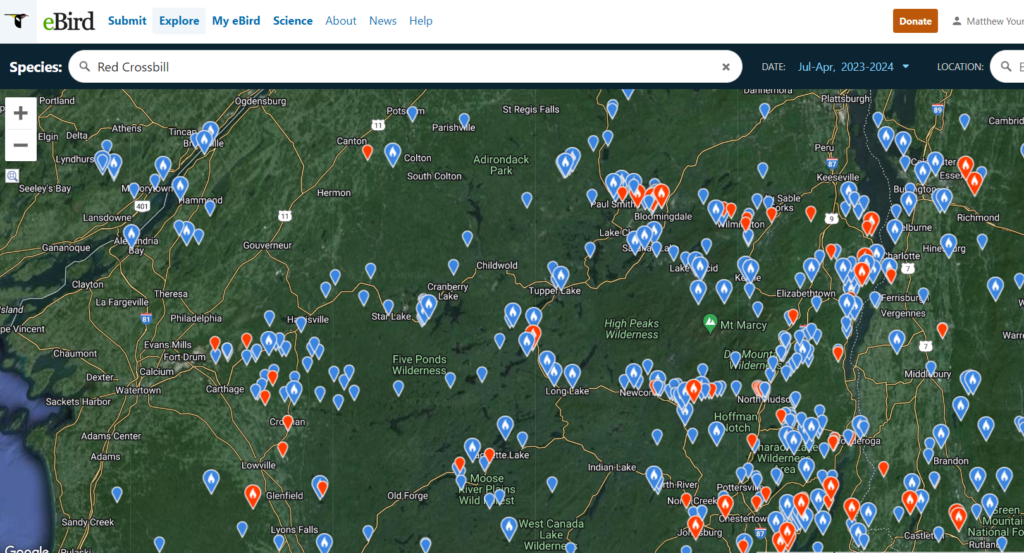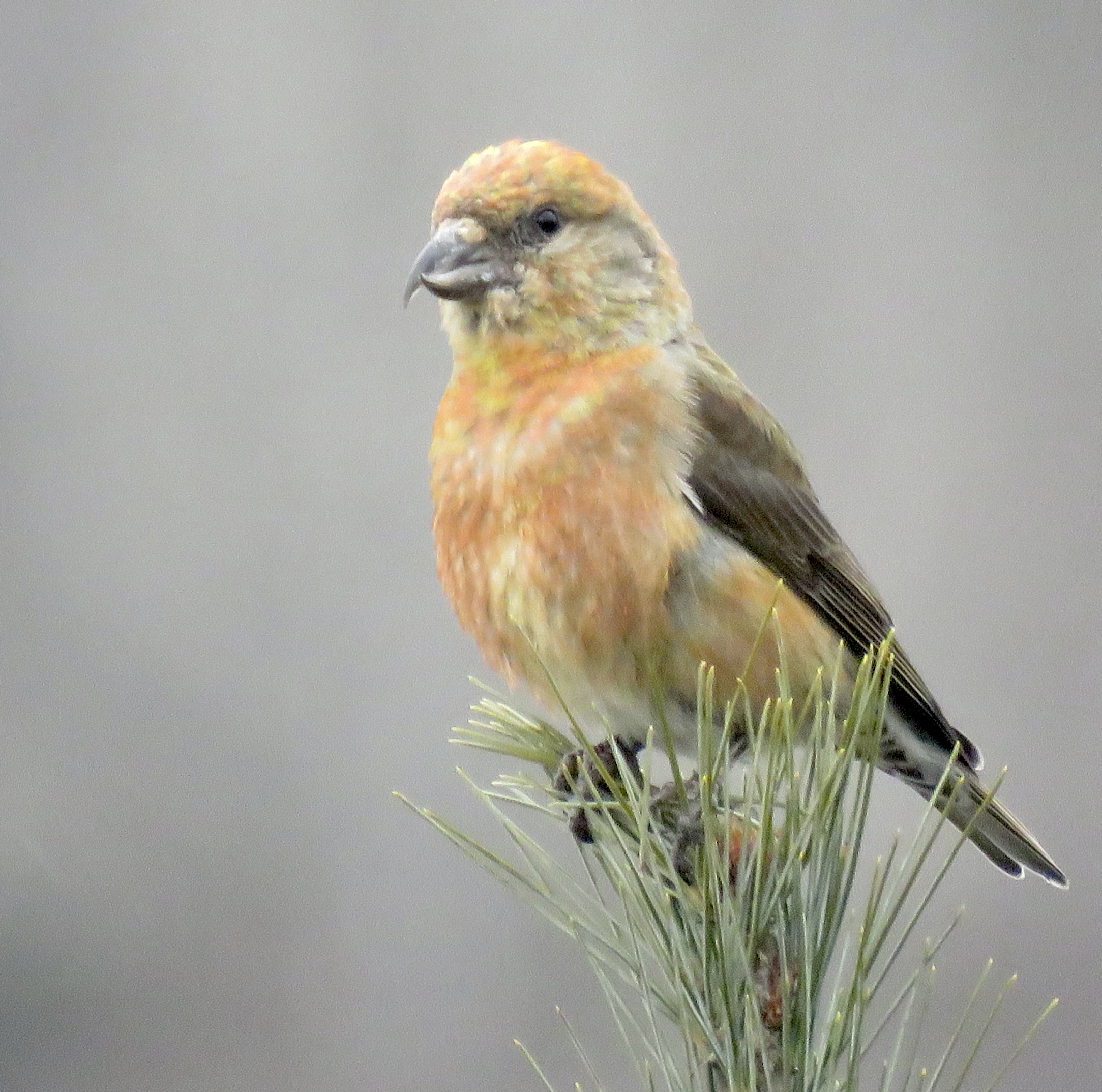By Rayna Bidwell
Exploring Winter Finch Food Sources in the Northwestern Adirondacks: A Closer Look at Cone and Seed Crop Density
As a student at St. Lawrence University, hailing from suburban Connecticut, exploring the Adirondacks and witnessing the boreal species it harbors has been an inspirational and unique experience for me. Over the course of my time here, I have grown a great appreciation for the avian residents of upstate New York, which led me into this amazing project I had the honor of working on this past fall.
In recent years, the decline of bird populations across North America has raised concerns about the future of our feathered friends. Long term surveys throughout the continental United States and Canada have estimated a net loss of 2.9 billion birds across all biomes, with more than 90% being attributed to 9 bird families, including the finch family Fringillidae (Rosenburg et al. 2019). In order to conserve species that exhibit irruptive behavior, such as the winter finches of the northeast, it is important to understand when and where they will be around. These birds traverse vast distances, following the trail of abundant food sources. To predict their movements, it’s essential to grasp the annual reproductive patterns of the specific tree species they feed from.
As many here are likely aware, the Finch Research Network (FiRN) spearheaded a citizen science project on iNatualist to document tree species and their seed crops. While anecdotal information on food crops across the boreal is super important to help predict finch irruptions, my advisor Dr. Susan Willson and I decided to try to refine the methods to ensure replicability and reliability for those that want to use a more scientific survey approach.
To maintain consistency in my surveys, I drove along preselected roads within suitable finch habitat in the northwest section of the Adirondack Park, stopping every 0.10 mile. At each stop, I used binoculars to observe up to five mature trees of each of the listed species present within a roughly 30 m radius from the car. Like the iNaturalist survey, I scored the seed crop of each tree on a scale of 0-11, with 0 being “none” and 11 being “bumper crop.” I also made sure to note the reproductive stage of each tree, especially in the case of cone crops, which may vary in terms of “cone ripeness”.

A satellite view of one of the routes I surveyed, with my stopping points. This is Stark Road, located in South Colton, NY
From my observations, Balsam fir had the highest average cone rating, followed by Scotch pine, red pine, white pine, and red spruce. However, the overall outlook was bleak, with no average cone crop surpassing 5. These findings align with the trends outlined in the Winter Finch Forecast, indicating poor to below-average cone crops throughout the boreal forest (Hoar 2023). This also aligns with my personal observations, as most trees were fairly devoid of cones. Those that had them were usually past the end of their cone cycle, with dry and open cones unsuitable for feeding birds.
Mean rating scores of the tree species I observed, showing balsam fir to have the highest and red spruce to have none.

Looking ahead, the variability of cone production poses challenges for both researchers and birds alike. While some years may yield bumper crops, others may falter due to environmental stressors like drought. Niche segregation among finch species also further complicates matters, with preferences for deciduous or coniferous seeds dictating their foraging habits. Red Crossbills even appeared rare in the area I surveyed despite them being common in the eastern Adirondacks this past winter. The Eastern white pine crop was poor in the area I surveyed, which is different from what has been observed in the eastern parts of the Adirondacks.

Despite the uncertainties, this study underscores the importance of long-term monitoring to gauge the Adirondacks’ viability as a finch habitat. Only through continued observation can we unravel the mysteries of cone cycles and ensure the survival of these cherished birds for generations to come.
References
Hoar, T. (2023, November 11). 25th Annual Winter Finch Forecast (2023). Finch Research Network. https://finchnetwork.org/winter-finch-forecast-2023-2024
Rosenberg, K. V., A. M. Dokter, P. J. Blancher, J. R. Sauer, A. C. Smith, P. A. Smith, J. C. Stanton, A. Panjabi, L. Helft, M. Parr, and P. P. Marra. 2019. Decline of the North American avifauna. Science 366:120-124.
Rayna Bidwell: I’m an undergraduate senior student at St. Lawrence University. I grew up in Ellington, Connecticut and have always had a passion for wildlife and nature. I’m primarily interested in herpetology but have grown a great appreciation for ornithology and birdwatching during my time in college.
For more on the Evening Grosbeak project, also see Sax Zim Bog’s executive director Sparky Stensaas’ YouTube video: https://www.youtube.com/watch?v=4vyW9jNg0JM
And for more on Crossbills, also see this video Sparky put together: https://www.youtube.com/watch?v=_r2wqY8DHPk
Sparky’s YouTube channel can be found here: https://www.youtube.com/c/SparkyStensaas
For more on Red Crossbills, see this Life List podcast: https://podcasts.apple.com/us/podcast/understanding-red-crossbill-types-and-other-finches/id1578168978?i=1000652011742
FiRN is a nonprofit, and was granted 501c3 status in 2020. We are a co-lead on the Evening Grosbeak Road to Recovery Project, and have funded upwards of almost $8,000 to go towards research, conservation and education for finch projects in the last year plus. FiRN is committed to researching and protecting these birds and other threatened finch species like the Evening Grosbeak, Rosy-finches, and Hawaii’s finches the honeycreepers, and if you have been enjoying all the blogs and identifying of Evening Grosbeak and Red Crossbill call types (upwards of 20,000 recordings listened to), redpoll subspecies and green morph Pine Siskins FiRN has helped with over the years, please think about supporting our efforts and making a small donation at the donate link below.
Donate – FINCH RESEARCH NETWORK (finchnetwork.org)
Shirt Link
For a commemorative Winter Finch Forecast shirt where proceeds will go towards the study and conservation of finches and their habitats globally, see here: https://finchnetwork.org/shop
Please think about joining these Finch Research Network iNaturalist Projects:
Winter Finch Food Assessment Project/Become a Finch Forecaster: https://finchnetwork.org/the-finch-food-assessment-become-a-finch-forecaster
Red Crossbill North American Foraging Project: https://finchnetwork.org/crossbill-foraging-project
Evening Grosbeak North American Foraging Project: https://finchnetwork.org/evening-grosbeak-foraging-project

